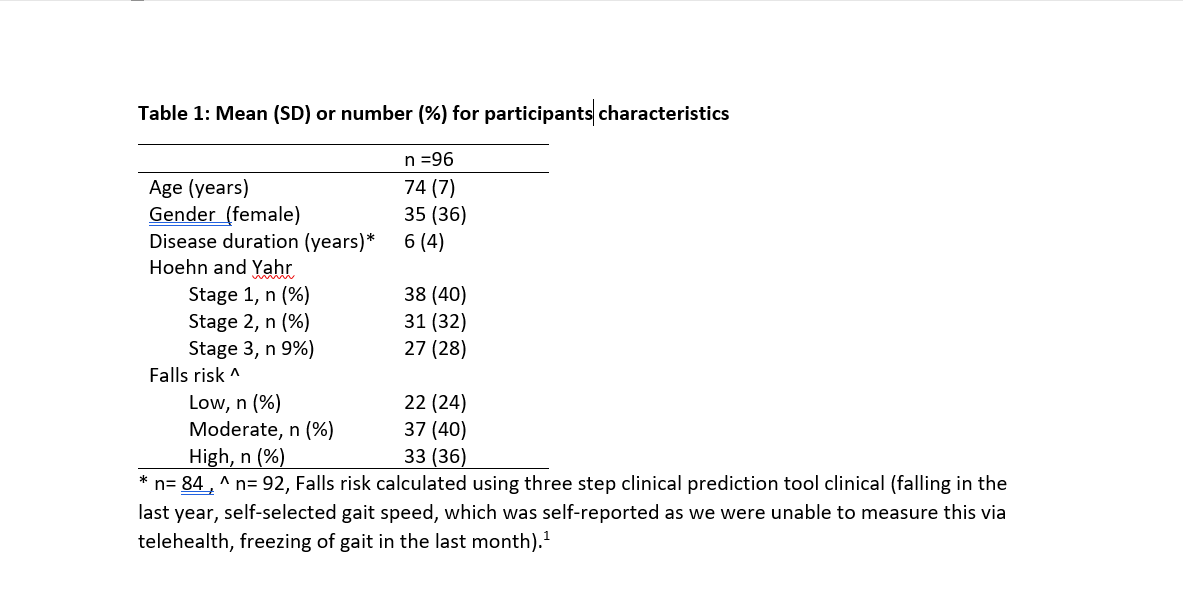Objective: To determine if telehealth physiotherapy can support people with Parkinson’s disease to transition from a clinic-based group exercise program to home-based exercise.
Background: Exercise is an integral component of the physiotherapy management of Parkinson’s disease. Home-based exercise is convenient, affordable and accessible. Telehealth provides one option for providing sustainable, long-term, home-based exercise.
Method: A mixed methods, retrospective file audit study. People with Parkinson’s disease who were attending weekly physiotherapy group exercise classes were transitioned to home-based telehealth physiotherapy due to COVID-19. Participants were prescribed a home exercise program using exercises selected from the PhysioTherapy eXercises website and completed the program three times a week. Participants received a weekly telephone call to monitor and progress their exercises. The telehealth service was offered for 21 weeks. The primary outcome was adherence with the exercise program, measured by the percentage of prescribed sessions completed. Secondary outcomes included physical activity data collected at the start and end of telehealth. Semi-structured interviews were conducted with 13 participants. The interviews were digitally recorded, transcribed verbatim and analysed thematically.
Results: Preliminary results show of the 121 people with Parkinson’s disease attending the exercise classes prior to COVID-19, 96 (79%) received a minimum of four telehealth sessions (mean 10, SD 3). See Table 1 for participant characteristics. Adherence to the exercises sessions was very high with a mean of 108% (SD 46%, range: 29-231%) of sessions completed. On average people spent 32 minutes (SD 11, range 13-82) per session, and 100 minutes (SD 53, range 27 – 290) exercising per week. The average number of steps per day was similar at the start (10, 927; SD 5094; range 3026 – 28 666) and end (11,305; SD 4,338; range 2906 – 24 889) of telehealth.
Participants highly valued the holistic nature of weekly telephone calls, with most finding the telephone calls motivating. Participants reported a lack of feedback and equipment made exercising at home more difficult than in the clinic.
Conclusion: People with Parkinson’s disease were able to continue exercising at home when supported with physiotherapy provided via telehealth. People with Parkinson’s disease highly valued the opportunity to have regular contact with the physiotherapist.
References: 1. Paul SS, Canning CG, Sherrington C, Lord SR, Close JC, Fung VS. Three simple clinical tests to accurately predict falls in people with Parkinson’s disease. Mov Disord 2013;28(5):655-662.
To cite this abstract in AMA style:
A. Flynn, C. Canning, E. Preston, S. Dennis, N. Allen. Can telehealth support people with Parkinson’s disease to exercise at home? [abstract]. Mov Disord. 2021; 36 (suppl 1). https://www.mdsabstracts.org/abstract/can-telehealth-support-people-with-parkinsons-disease-to-exercise-at-home/. Accessed December 22, 2025.« Back to MDS Virtual Congress 2021
MDS Abstracts - https://www.mdsabstracts.org/abstract/can-telehealth-support-people-with-parkinsons-disease-to-exercise-at-home/

